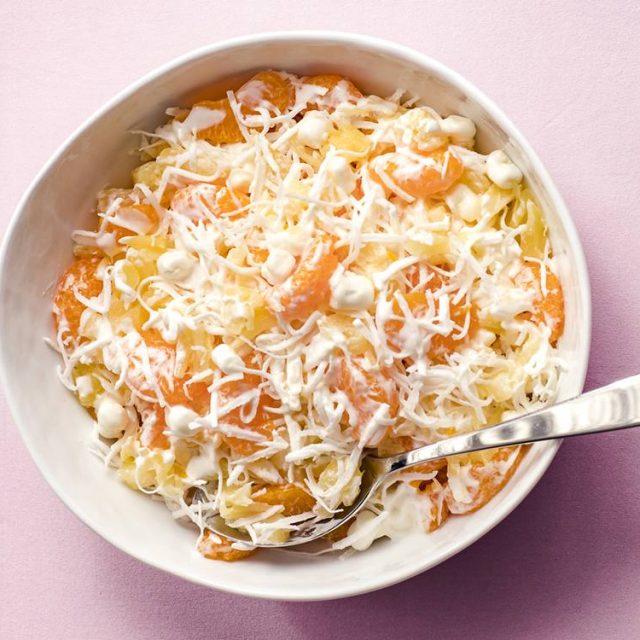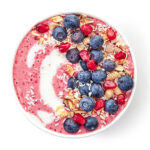Indulge in the blissful world of flavors with our quick and straightforward ambrosia recipe. This classic fruit salad, known for its heavenly combination of whipped cream, fruit, and marshmallows, offers a delightful treat that’s both effortless to make and impossible to resist. Join us as we unveil the secrets to crafting this divine dessert, perfect for any occasion or simply satisfying your sweet cravings.
| Ingredients: | |
| 1 | 2 cups whipped cream (or topping) |
| 2 | 1 cup mini marshmallows |
| 3 | 1 cup shredded coconut |
| 4 | 1 can (20 oz) pineapple chunks, drained |
| 5 | 1 can (11 oz) mandarin orange segments, drained |
| 6 | 1 cup maraschino cherries, drained and halved |
| 7 | 1/2 cup chopped nuts (such as pecans or walnuts), optional |
Step-by-step cooking instruction of Easy ambrosia recipe:
Step-1 In a large mixing bowl, combine the whipped cream (or whipped topping) and mini marshmallows. Gently fold them together.
Step-2 Add the shredded coconut to the bowl and gently mix it into the cream and marshmallow mixture.
Step-3 Next, add the drained pineapple chunks and mandarin orange segments to the bowl. Gently fold them into the mixture.
Step-4 Carefully fold in the halved maraschino cherries. If you’re using nuts, you can add them at this stage as well.
Step-5 Once everything is combined, cover the bowl with plastic wrap or a lid and refrigerate for at least 1-2 hours before serving. Chilling allows the flavors to blend.
Step-6 Before serving, give the ambrosia a gentle stir. You can also garnish with a few extra maraschino cherries and a sprinkle of coconut on top.
Step-7 Serve the ambrosia as a side dish or dessert at your desired occasion!
Nutritional values of Easy ambrosia recipe:
Nutrition Values (per serving, based on 6 servings):
| 1 | Calories: ~280 |
| 2 | Total Fat: ~14g |
| 3 | Saturated Fat: ~10g |
| 4 | Cholesterol: ~20mg |
| 5 | Sodium: ~50mg |
| 6 | Total Carbohydrates: ~38g |
| 7 | Dietary Fiber: ~2g |
| 8 | Sugars: ~31g |
| 9 | Protein: ~2g |
Background History of Easy ambrosia recipe:
The history of ambrosia is a fascinating journey that blends culinary traditions, cultural influences, and the evolution of taste. While the exact origins of ambrosia are not definitively documented, its roots can be traced back to the Southern United States, where it gained popularity as a cherished dessert. The term “ambrosia” itself has mythological origins, stemming from Greek mythology where it referred to the food of the gods that bestowed immortality.
The concept of ambrosia as a culinary creation likely emerged in the late 19th or early 20th century. During this time, a wave of cookbooks and household guides began to circulate, featuring recipes that showcased the flavors and ingredients of the region. The warm climate of the South allowed for an abundance of citrus fruits, coconut, and other tropical ingredients that were often incorporated into recipes.
The basic components of ambrosia – fruits, whipped cream or other creamy elements, and sweet add-ins like marshmallows – align with the preferences of that era when sweet and indulgent dishes were highly prized. These ingredients were readily available and could be easily combined to create a dessert that was both visually appealing and delectably satisfying.
Ambrosia’s popularity continued to grow over time, becoming a staple at potlucks, family gatherings, and holiday feasts. It embodied the spirit of Southern hospitality and comfort, a dish that brought people together and evoked a sense of nostalgia.
In recent years, ambrosia has seen various reinterpretations and modern twists. Some versions lean towards healthier ingredients, incorporating fresh fruits and lighter dairy options, while others maintain the traditional components with a few contemporary updates.
Today, ambrosia remains a beloved classic that transcends generations. Its history reflects the cultural and culinary evolution of the American South, while its enduring appeal lies in its simplicity, versatility, and ability to evoke fond memories. Whether enjoyed as a side dish, dessert, or standalone treat, ambrosia continues to bring a touch of timeless delight to tables around the world.
| Advantages of Easy ambrosia recipe | |
| 1 | Simplicity: The recipe is straightforward and easy to follow, making it accessible even for novice cooks. |
| 2 | Quick Preparation: The ambrosia comes together relatively quickly, requiring minimal cooking or baking time. |
| 3 | Fruit Variety: Ambrosia incorporates a variety of fruits, providing a range of flavors and textures in a single dish. |
| 4 | Customizable: You can easily customize the recipe by adding or substituting fruits based on personal preferences or seasonal availability. |
| 5 | No-Bake: This recipe doesn’t require any baking, making it a convenient option, especially during warmer months when you might want to avoid heating up the kitchen. |
| 6 | Appealing Presentation: The vibrant colors and arrangement of fruits make ambrosia visually appealing, suitable for potlucks, parties, and gatherings. |
| Disadvantages of Easy ambrosia recipe | |
| 1 | Sugar Content: Ambrosia typically contains a significant amount of added sugars from marshmallows, canned fruits, and coconut. Those watching their sugar intake may be concerned about this. |
| 2 | Calorie Density: The whipped cream, marshmallows, and coconut contribute to the dish’s calorie density, which may not be suitable for those looking to manage their weight. |
| 3 | Nutritional Balance: While it contains fruit, ambrosia may lack the nutritional balance of a complete meal. It’s more of a dessert or side dish rather than a substantial source of nutrients. |
| 4 | Allergens: The recipe includes common allergens like dairy (whipped cream) and nuts. People with allergies need to be cautious or make substitutions. |
| 5 | Processed Ingredients: Canned fruits and marshmallows are processed ingredients with additives and preservatives that may not align with a whole-foods-based diet. |
| 6 | Texture Preferences: Some individuals might not enjoy the combination of soft and chewy textures from marshmallows and coconut. |
| 7 | Cultural and Dietary Considerations: Ambrosia may not be suitable for certain dietary preferences (e.g., vegan, gluten-free) or cultural tastes. |
Compare with Similar meal of Easy ambrosia recipe:
If you’re looking for similar meals or dishes that share some of the characteristics of an easy ambrosia recipe – such as being fruity, refreshing, and suitable for gatherings – here are a few options to consider:
| 1 | Fruit Salad: A classic choice, a fruit salad allows you to showcase a variety of fresh, seasonal fruits. You can mix and match fruits based on your preferences and add a touch of citrus juice or a simple honey-lime dressing for added flavor. |
| 2 | Yogurt Parfait: Layer yogurt with granola and a medley of fruits for a nutritious and visually appealing dessert or breakfast option. For added sweetness, you can also sprinkle some honey over the dish. |
| 3 | Berry Trifle: Create layers of cake, custard or yogurt, and mixed berries for a decadent yet light dessert that’s perfect for special occasions. |
| 4 | Pavlova: This meringue-based dessert is topped with whipped cream and fresh fruits. It offers a delightful combination of crunchy and creamy textures. |
| 5 | Fruit Salsa with Cinnamon Chips: Dice fruits like mangoes, strawberries, and kiwi, then serve them with homemade cinnamon-sugar tortilla chips for a fun and flavorful snack. |
| 6 | Coconut Rice Pudding with Fresh Fruits: A creamy rice pudding made with coconut milk and served with a medley of tropical fruits is a satisfying and exotic dessert option. |
| 7 | Smoothie Bowl: Blend your favorite fruits into a thick smoothie and top it with granola, nuts, seeds, and additional fruit slices for a nutritious and colorful breakfast or snack. |
| 8 | Frozen Fruit Bars: Make your own fruit popsicles by blending fruits with a bit of yogurt or juice and freezing them in molds. |
| 9 | Mixed Berry Salad: Combine berries like strawberries, blueberries, and raspberries with a light dressing made from honey and lemon juice for a simple and refreshing salad. |
| 10 | Grilled Fruit Skewers: Thread chunks of fruit onto skewers and grill or roast them for a slightly caramelized and smoky flavor. |
Mostly questions asked about Easy ambrosia recipe
1: What is ambrosia salad?
A: Ambrosia salad is a classic dessert made with a combination of whipped cream, fruits like pineapple and oranges, marshmallows, and coconut. It’s known for its sweet and creamy flavors.
2: Can I use fresh fruits instead of canned ones?
A: Yes, you can definitely use fresh fruits in your ambrosia salad. It can add a burst of natural flavors and textures. Just make sure to adjust the quantities and drain excess juices to prevent the salad from becoming too watery.
3: Is ambrosia salad served as a side dish or dessert?
A: Ambrosia salad is quite versatile and can be served as either a side dish or a dessert. It’s often seen at potlucks, barbecues, holiday dinners, and picnics.
4: Can I make ambrosia salad ahead of time?
A: Yes, ambrosia salad can be made ahead of time. However, it’s best to add the marshmallows just before serving to maintain their texture.
5: Are there any healthier alternatives to whipped cream?
A: Yes, you can use Greek yogurt or a mixture of Greek yogurt and whipped cream to make a lighter version of ambrosia salad.
6: What can I substitute for coconut if I’m not a fan?
A: If you’re not a fan of coconut, you can simply omit it or replace it with chopped nuts for a different texture and flavor.
7: Can I add other fruits to my ambrosia salad?
A: Absolutely! You can personalize your ambrosia salad by adding fruits like grapes, bananas, strawberries, or berries.
8: Is ambrosia salad suitable for vegetarians?
A: Yes, ambrosia salad can be made vegetarian-friendly as long as you ensure that all the ingredients you use are vegetarian.
9: Can I make ambrosia salad vegan?
A: Yes, you can make a vegan version of ambrosia salad by using non-dairy whipped cream or coconut whipped cream, vegan marshmallows, and plant-based yogurt.
10: How do I store leftover ambrosia salad?
A: Refrigerate any leftover ambrosia salad in an airtight container. Make sure to consume it within a day or two for the best taste and texture.







